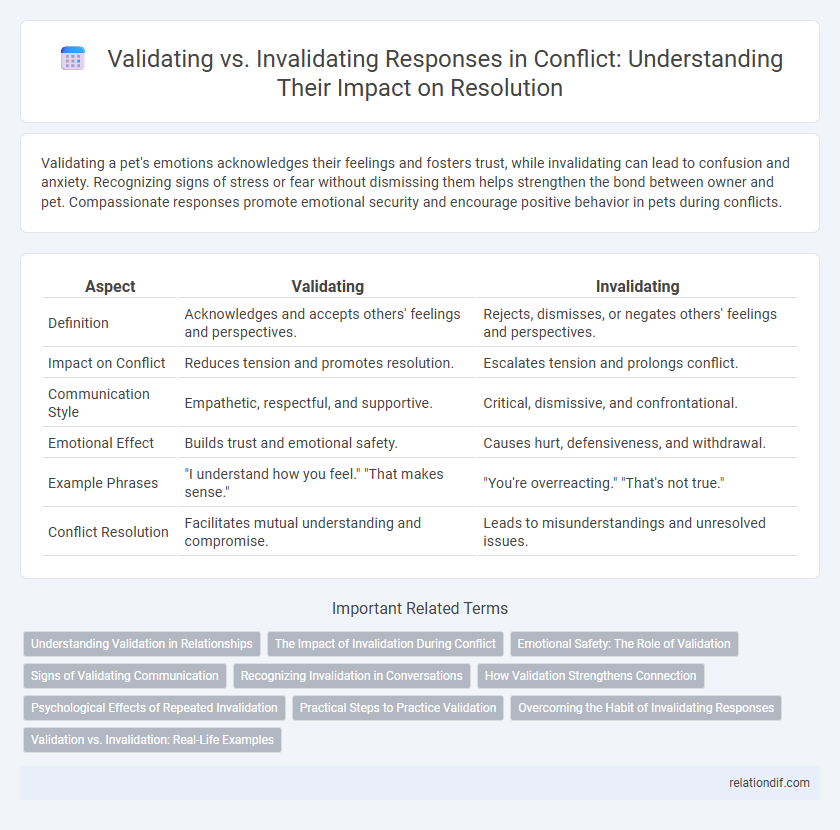Validating a pet's emotions acknowledges their feelings and fosters trust, while invalidating can lead to confusion and anxiety. Recognizing signs of stress or fear without dismissing them helps strengthen the bond between owner and pet. Compassionate responses promote emotional security and encourage positive behavior in pets during conflicts.
Table of Comparison
| Aspect | Validating | Invalidating |
|---|---|---|
| Definition | Acknowledges and accepts others' feelings and perspectives. | Rejects, dismisses, or negates others' feelings and perspectives. |
| Impact on Conflict | Reduces tension and promotes resolution. | Escalates tension and prolongs conflict. |
| Communication Style | Empathetic, respectful, and supportive. | Critical, dismissive, and confrontational. |
| Emotional Effect | Builds trust and emotional safety. | Causes hurt, defensiveness, and withdrawal. |
| Example Phrases | "I understand how you feel." "That makes sense." | "You're overreacting." "That's not true." |
| Conflict Resolution | Facilitates mutual understanding and compromise. | Leads to misunderstandings and unresolved issues. |
Understanding Validation in Relationships
Understanding validation in relationships strengthens emotional connection by recognizing and affirming a partner's feelings and perspectives. Validation fosters trust and reduces conflict by showing empathy and respect, which helps de-escalate misunderstandings. Consistent validation promotes healthy communication patterns essential for resolving disputes and building lasting intimacy.
The Impact of Invalidation During Conflict
Invalidation during conflict significantly escalates emotional distress and hinders communication by dismissing an individual's feelings or perspectives. This behavior fosters resentment and deepens misunderstandings, ultimately prolonging disputes and reducing the likelihood of resolution. Studies show that perceived invalidation impairs conflict resolution skills and intensifies relational strain.
Emotional Safety: The Role of Validation
Validation plays a crucial role in fostering emotional safety during conflicts by acknowledging and legitimizing others' feelings, which promotes trust and open communication. Invalidating responses, such as dismissing or minimizing emotions, often escalate tension and hinder resolution. Prioritizing validation helps de-escalate conflicts and supports the development of empathetic understanding between parties.
Signs of Validating Communication
Signs of validating communication in conflict include active listening, acknowledging the other person's feelings, and expressing empathy without judgment. Using affirming language that recognizes the other's perspective fosters mutual respect and de-escalates tension. Maintaining open body language and timely responses also reinforce validation, promoting constructive dialogue and resolution.
Recognizing Invalidation in Conversations
Recognizing invalidation in conversations involves identifying dismissive language, such as minimization of feelings or outright denial of experiences, which undermines the speaker's perspective. Signs of invalidation include frequent interruptions, sarcastic remarks, or ignoring expressed emotions, ultimately escalating conflicts and eroding trust. Being aware of these behaviors helps maintain constructive communication and fosters emotional safety.
How Validation Strengthens Connection
Validation during conflict fosters emotional safety by acknowledging and affirming the other person's feelings, which reduces defensiveness and promotes trust. Recognizing and empathizing with perspectives enhances mutual understanding and encourages open communication. Strengthened connection through validation supports collaborative problem-solving and long-term relationship resilience.
Psychological Effects of Repeated Invalidation
Repeated invalidation in conflict situations can lead to chronic stress, diminished self-esteem, and increased feelings of anxiety or depression. Psychological effects often include emotional dysregulation, where individuals struggle to manage their feelings, and a pervasive sense of worthlessness. Over time, these impacts impair interpersonal relationships and contribute to long-term mental health issues.
Practical Steps to Practice Validation
Practicing validation in conflict involves actively listening to the other person's perspective without interrupting, acknowledging their feelings with empathetic statements, and reframing their concerns to show understanding. Using phrases like "I hear that you're feeling..." or "It sounds like..." can help convey genuine recognition of their experience. These practical steps foster a safe environment that reduces defensiveness and encourages open, constructive dialogue.
Overcoming the Habit of Invalidating Responses
Overcoming the habit of invalidating responses in conflict requires actively recognizing and respecting others' feelings and perspectives without dismissiveness. Validating communication fosters empathy, reduces defensiveness, and promotes constructive dialogue essential for resolution. Neuroscientific studies show that validation can decrease stress responses and increase feelings of safety during difficult conversations.
Validation vs. Invalidation: Real-Life Examples
Validation involves acknowledging and respecting someone's emotions or experiences, such as listening actively when a colleague expresses frustration about a project delay. Invalidation occurs when those feelings are dismissed or minimized, for example, telling a friend they are "overreacting" during a personal crisis. Real-life conflict resolution improves significantly when validation fosters empathy and trust, while invalidation often escalates misunderstandings and emotional distance.
validating vs invalidating Infographic

 relationdif.com
relationdif.com